This homemade Canadian bacon made of cured pork loin with mild maple and sage flavours eclipses any commercially available Canadian bacon I’ve ever had in my entire life.
It’s no secret that my house is a big fan of meat in general and pork specifically. Within the subset of pork, bacon of all sorts makes my guys sing with joy.
When I made homemade bacon a handful of weeks back, one of my kids walked by happily munching a strip of crispy bacon wondering aloud, “I wonder if mom could make Canadian bacon, eh?”
They followed up that statement with a quick, “That was a Canadian ‘eh’, not a Michigan one.” and then some manic giggling. Glad to see my kids are working on their regional accents.
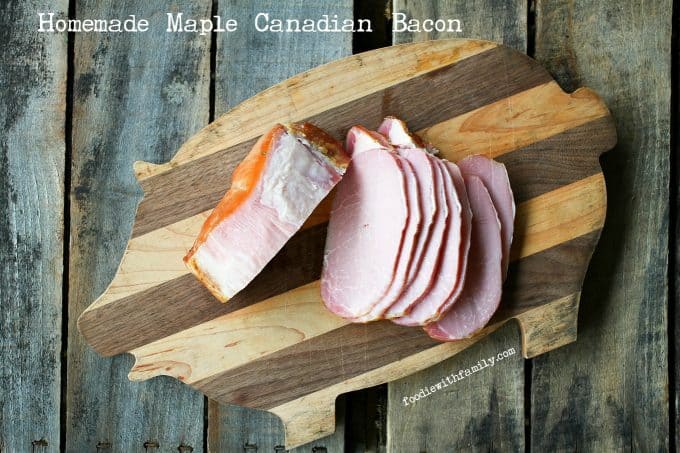
That challenge, even though it wasn’t directly delivered to me, got me to thinking. If I could make regular old American bacon, why in the world couldn’t I make some fabulous North-of-the-border bacon?
Canadian Bacon is a many splendored thing. Because it’s so lean, you really only need to heat it through rather than fry it up like our beloved American bacon making it a faster, more convenient breakfast on-the-go option.
And honestly, it’s not even really Canadian. The Canadians make pea meal bacon.
You wanna know what’s nuts? How ridiculously easy MAKING Canadian bacon is.
Mercy, though, the ease with which this is prepared pales in comparison to how insanely delicious the end product is. Cured pork loin with mild maple and sage flavours eclipses any commercially available Canadian bacon I’ve ever had in my entire life.
My unofficially official taste-testing panel of my husband and sons agreed completely. In fact, this Canadian bacon has been added to not one, not two, but THREE birthday meal requests!
What Is Canadian Bacon
The perfect Canadian bacon starts with a good chunk of readily available boneless pork loin. I’m not talking about pork tenderloins, I’m talking about center cut, lean pork loin.
Many grocers sell this in a vacuum sealed package in large amounts. This recipe makes enough brine for 4 pounds of loin, but you can upsize the brine if you get a monstrous huge loin, eh? (And I’m sorry, but that really was more of a Michigan ‘eh’ than a Canadian one…)
I feel obliged to make Canadian bacon pretty Canadian so I added a goodly slug of Grade B dark maple syrup to the brine. It gives it that something special!
If you can’t get the dark Grade B, go for a good A. The darker the syrup, the stronger the maple flavour!
If you can’t get maple syrup at all, feel free to sub in our brown sugar homemade pancake syrup. The result will be delicious if different.
Fresh sage is where it’s at, folks. Grab a bundle from the grocery store, or a handful from your neighbor’s garden (with their permission, of course!) but do splurge on the fresh sage.
And hot on the heels of my fresh sage argument, I’m going to tell you that dried whole leaf thyme is a-okay here! Fresh thyme is nice, but not quite as crucial to the finished product as the fresh sage.
Before dunking the pork loin into the brine, trim as much fat off as you can. You don’t need to be surgical, as it will be easier to remove from the Canadian Bacon AFTER it’s smoked or cooked in the oven. You can reserve the cured, smoked or roasted fat to render and add to beans.
I prefer to cut the pork loin to pieces that are a size that fit comfortably into a gallon freezer bag so they stay submerged in the brine like good little bacon.
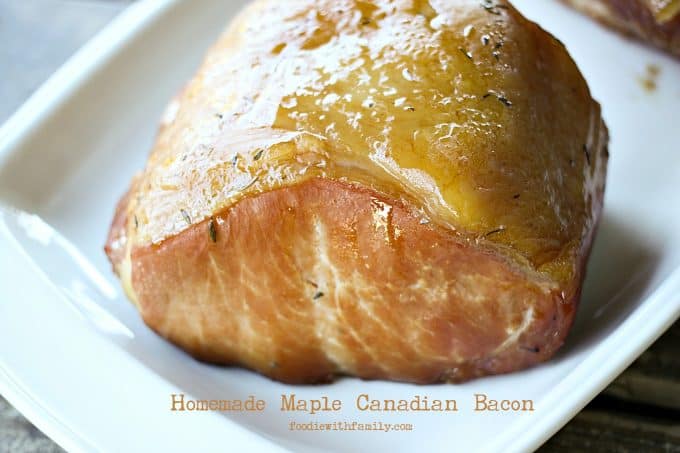
Smoking the brined Canadian Bacon over applewood is FABULOUS and preferable, but if you have no access to a smoker, you can put it in a very low temperature oven (with a little smoke box if you own one!) until the internal temperature reaches 150°F. I’ve included instructions for both methods in the recipe.
This keeps in the refrigerator for up to 10 days (courtesy of the pink salt used in the brine) but keeps far longer if tightly wrapped and stashed in the freezer.
Speaking of pink salt. I did choose to use it here.
I adapted my recipe from Michael Ruhlman’s “Charcuterie” and he makes a pretty powerful argument in favour of its use. If you choose to omit this, understand that it will shorten the shelf life in the refrigerator as well as alter the colour to more of a brown than a pink.
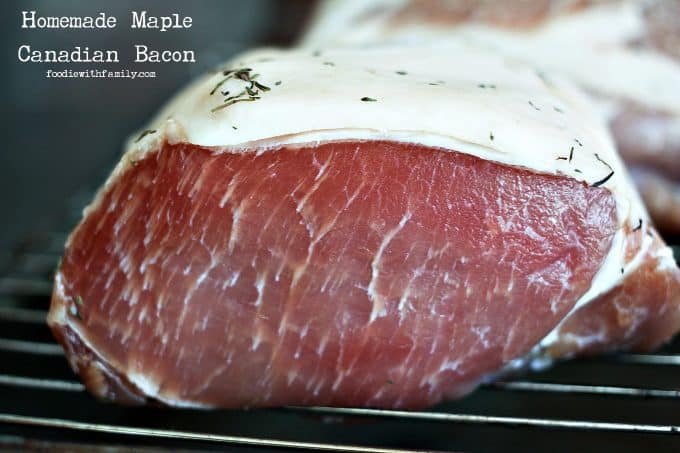
It also increases the risk of bacterial growth in the meat. Please note this means curing powder pink salts not Himalayan. The technical term for this is Prague Powder #1.
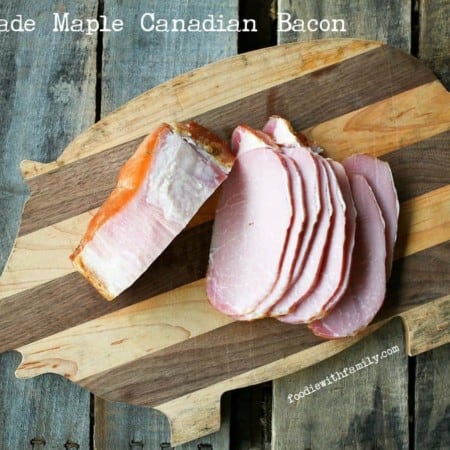
Homemade Maple Canadian Bacon {Smoker Optional}
Rate RecipeIngredients
- 1 gallon water 4 liters
- 1 1/2 cups Morton’s kosher salt 350 grams
- 1 cup raw sugar 250 grams
- 8 teaspoons pink salt 42 grams
- 1 cup Grade B Dark Maple Syrup 236 ml
- 1 bunch fresh sage
- 1 tablespoon dried thyme
- 2 garlic cloves peeled and smacked with the side of a knife to lightly crush
- 4 pounds boneless pork loin excess fat removed
Instructions
- Combine the water, salt, sugar, pink salt, maple syrup, sage, thyme, and garlic cloves in a stockpot. Bring to a simmer and stir to dissolve the sugar and salt. Remove from the heat and refrigerate until chilled all the way through. Trim the pork loin down to fit into two or more gallon sized resealable freezer bags. Insert the pork loin in the bags, then pour the cooled brine into the bags to cover the loins. Squeeze as much air as possible from the bags, then place the filled bags in a high-sided roasting pan and place the pan in the refrigerator for 72 hours.
- After 72 hours, drain the brine, rinse the pork loins, and place on a rack over a baking sheet. Put that back into the refrigerator for 24 hours to air dry.
To Smoke the Canadian Bacon:
- Hot smoke at 200°F over applewood chips for 2 to 3 hours, according to your smoker manufacturer’s instructions, or until the internal temperature of the pork loin reaches 150°F.
To Roast the Canadian Bacon:
- Preheat your oven to 200°F. Take the air-dried pork loin and put it in the oven still on its rack over its pan, and cook until the internal temperature reaches 150°F.
- Trim any remaining excess fat, then allow to cool to room temperature. Wrap the pork tightly and refrigerate for up to 10 days or wrap in a double layer of plastic wrap then a layer of foil and freeze for up to 6 months.
Nutrition
Nutritional information is an estimate and provided to you as a courtesy. You should calculate the nutritional information with the actual ingredients used in your recipe using your preferred nutrition calculator.
did you make this recipe?
Make sure to tag @foodiewithfam on Instagram and #hashtag it #foodiewithfamily so I can check it out!
Need a little help finding some Pink Salts for curing your meat? Here’s a handy-dandy Amazon affiliate link to some Prime eligible Pink Salt!
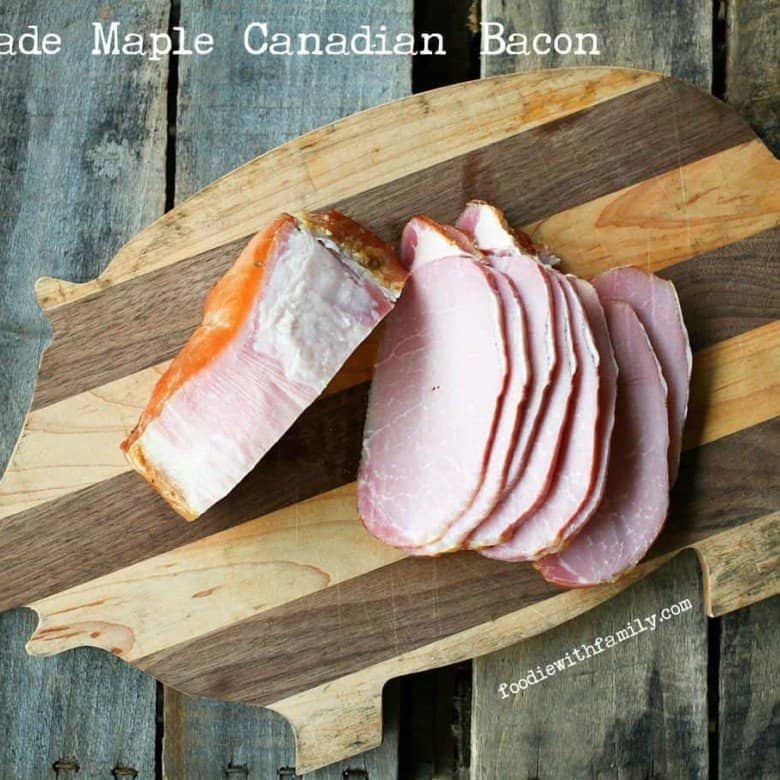



Reader's Thoughts...
Bob kaz says
I followed your recipe to the letter although I had reservations about the amount of curing salt. When it came out of the smoker it looked picture perfect. Could not eat it. Way too much salt. I think your 8 tsp of curing salt is way over the top. Other recipes called for one tsp. I washed it throughly after the cure so that was not the problem. Just sayin.
Lynn says
In your recipe it just called for pink salt and I picked up Himalayan. What will that do? And how long will.you have to roast at 200 degrees?
Rebecca says
Hi Lynn- I’m afraid the Himalayan pink salt is not the same thing as curing pink salt. In order to make this, you need curing salt (a.k.a. Prague Powder #1.) As for roasting, you have to go until the internal temperature of the pork is 150°F. Because pork loins vary in size, the amount of time this will take also varies. 🙂
Simon says
Just pulled this off my smoker, the only change I made was switching out Rosemary for the sage. It didn’t even make it to the cooking rack and we were already half way through eating a pound. Amazing. Thanks for the recipe.
Rebecca says
I’m so glad you loved these, Simon! Thank you for taking the time to both rate the recipe and let me know you loved it! I love the idea of rosemary swapped in for the sage!
Nat says
My husband is using this recipe For Canadian bacon, regular bacon, smoked turkey legs. This recipe is amazing.
Rebecca says
I’m so glad you guys love it, Nat!
Tom says
When I run this amount of meat and brine through a curing salt calculator, I get a result of 2.5 tsp vs the 8 tsp shown in the recipe. I used the calculator at AmazingRibs.com and checked that result with one I found at genuineideas.com. Everything I read tells me to be very careful with the amount of curing salt used.
Matt Schafer says
Can this brine be used for slab bacon?
Rebecca says
Hi Matt- I’d recommend trying this slab bacon recipe I have instead. 🙂
Ron Hilliard says
I just tried this. Only had a two pound loin, so cut all ingredients in half.
I’m worried there is too much pink salt. The meat is very salty.
Is it safe to eat?
Rebecca says
Can you confirm what kind of pink salt you used, Ron?
Ron Hilliard says
Cure #1
Steven says
For Bryan and Ed, I too used the recipe exactly and obtained inedible results. I checked out an article called the “The Science of Curing Meats Safely” and determined that the cut of the meat makes a big difference In the amount of salt and the amount of curing time. The author has a calculator to help properly adjust the ratio if you are adjusting a recipe. I also closely checked the curing salt I was using and the recommended ratio was 2 teaspoons for 10 pounds of meat. The amount of curing salt appears to vary significantly depending on the type of salt used. Retried the recipe with less curing salt and achieved much better result. The article was really worth the read…especially because I like Canadian Bacon so much. Thanks Rebecca for the idea!!!
Rebecca says
Hi Steven- I’m glad you liked the idea. The ratio of curing salt to water was the one recommended by Brian Polcyn and Michael Ruhlman in their acclaimed cookbook “Charcuterie” so I am confident in continuing my recommendation as written here. I’m not sure what’s getting lost in translation for those having issues with the results!
Jan Silvis says
This was the best pork loin I’ve ever had! My family can’t wait for me to make this again. Turkey breasts are on sale at the local market. Have you tried this recipe with turkey breasts? What allowances must be made for the bones? Thanks!
Rebecca says
Hi Jan- I have not tried this with turkey breast. Interesting idea! Unfortunately, I can’t really give you any guidance on that!
John says
What happens if you use refined white sugar? will this work also?
Rebecca says
I imagine it’ll work fine! That said, it’s an educated guess since I haven’t done that myself. 🙂
Byron says
Awesome. I made this for my son’s birthday today. Everyone loved it! I only cooked it in the oven this first time. I’ll try smoking it next time.
Sue says
I am Canadian and make pea meal bacon for our US friends . This recipe sounds tasty and I’ll have to try it. Eh?
Rebecca says
You’ll have to let me know what you think, Sue! I love pea meal bacon!
John Knight says
Hi Rebecca,
Going to give this a whirl this week and smoke it up on Saturday.
I also have 2 great looking pork bellies. Can I use the same curing recipe and smoke them at the same time?
Thanks again
Nice work
Rebecca says
Hi John- That sounds delicious!! I do have a bacon recipe here on the site if you’d like to compare the two. 🙂
Howard J Farr says
Just made this. Excellent results. Omitted the garlic and used a couple of bay leaves in the initial brine prep. I roasted my bacon. Left in brine for 6 days as opposed to the 72 hours here.
Rebecca says
I’m so glad you liked it! And thank you for taking the time to come back and rate the recipe. It is greatly appreciated!
Tim says
I think this recipe would be great and I made it as the recipe was written.
Is the salt measurement correct?
The bacon turned out so salty we can’t eat it.
Rebecca says
It is, Tim. Did you use the curing type of pink salt or Himalayan pink salt? And the brine was removed and the loins were rinsed before you smoked or baked them, right? This is a standard brine recipe with some additional aromatics added, so it should have been perfect. Did you specifically use Morton’s coarse kosher salt? Or did you use another type?
Carl Works says
When I made Canadian bacon I finished in the sous vide at 150° for 24 hours then smoked it for a couple of hours at 150. Came out juicy and completely precooked before I sliced it and vacuum sealed for the freezer in convenient sized packages.
Rebecca says
What a great idea, Carl!
Paul says
Just getting into “Canadian Bacon” Very informational and fun column. Inspirational even, makes me want to fire up the old smoker.
Rebecca says
Thanks, Paul!
Heather Ibbitson says
Grade B Canadian maple syrup? This compares to Grade B American syrup how?
Rebecca says
Grade B is Grade B. You’re good to go whether it’s Canadian or American.
Dallas Covington says
I wish people would make the correct reference regarding the “pink salt”. If the correct term of the salt is used there will be no confusion. Some people will actually use something like the Hawaiian Pink Salt which will not do your recipe justice and the wasted meat will be in the trash. The correct term is Curing Powder, Prague Powder #1. I use Hoosier Hill Farm Premium #1. I use it when making my smoked bacon as well. There are other makers of the curing powder, I just happen to use this one brand. Thank goodness I decided to go to Cordon Bleu of Seattle, and graduated from there learning about things such as ‘salts’. Not all salts are the same! *Lots of people do use the term pink salt, but I’m a little more anal about it as my head chef insists say what you mean and not what you say. It is the same as when someone describes caramelize. Many people say CAR -MEL- IZE, the correct term is CARA-MEL-IZE. Don’t mean to rag, but I like to have people avoid a train wreck when they follow a recipe. Please don’t take offense to this post. I am going to try your recipe. I tried my recipe the I use when making my smoked bacon. Looking for something a little different…which will be the sage and the B syrup. :o)
Rebecca says
Good points, Dallas. I’ll add to the notes to make sure people understand I’m referring to Prague Powder. The other thing that people have been misunderstanding is that the quantity of pink salts that go into the brine doesn’t make it into the finished protein. It’s a proper ratio for a brine!
P.S. I also say car-uh-mel and car-uh-mel-ize and nobody can make me stop! 🙂
Dallas Covington says
Haaa, in culinary school when the subject came up about caramelization, as we were all about ready to pronounce it incorrectly, the head chef instructor in our the class, in a loud voice in unison with the rest of the class he loudly said, CAR-A-MEL-IZE. All this time I had prounounced it wrong, like I had no clue. That’s one of the reasons why I enrolled in culinary school, to learn the minuscule in’s and out’s of what and why and how things in the pro kitchen are done. It was fun! Well I have my pork loins in the brine…now time to wait… thanks for responding…
Mike McCabe says
Do you need to cook the Canadian bacon after curing and smoking / baking i??